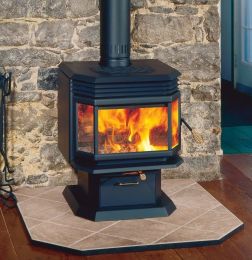 These take some of the heat from a wood or pellet burner and use it to heat your water. Being relatively expensive to install, a wetback makes most sense if your burner runs for much of each day through the winter – and it’s particularly cost-effective if you get cheap or free firewood.
These take some of the heat from a wood or pellet burner and use it to heat your water. Being relatively expensive to install, a wetback makes most sense if your burner runs for much of each day through the winter – and it’s particularly cost-effective if you get cheap or free firewood.
Because a wetback system can cause the water to boil, they are normally low-pressure and open to the atmosphere and you need a tempering valve to make sure the hot water you use is at no more than 55°C. Some mains-pressure cylinders come with a built-in heat exchanger, so it's possible to connect up a wetback system to heat the mains-pressure water indirectly.
Traditionally, the low-pressure water cylinder needed to be placed close to and above the burner, so that the heated water could rise into the cylinder. But it's now possible, with the aid of a special valve and smaller 20mm copper pipe, to locate the fire/wetback unit up to 40 metres away from the cylinder. This gives much greater freedom in siting both the fireplace and the water cylinder.
Unless you live in a rural area on a block bigger than two hectares, your log burner or pellet fire needs to meet the National Efficiency Standard with the wetback attached. This is something that lower-efficiency models can't do.
Wetbacks can be a good match with a solar water heater where you use the solid fuel burner as your main heating source. The solar unit heats the water during the summer months and the wetback during winter.
The main attractions: efficient use of an existing appliance. Can be very cheap to run depending on firewood costs.
The main drawbacks: wetbacks are expensive to install. Installation is dependent on type and location of cylinder and solid fuel burner.
- In most cases a budget price would be between $1200 - $1800 incl GST plus the cost of the fire and the hot water storage cylinder